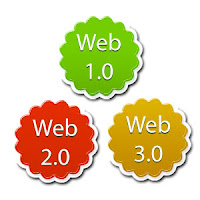 WEB 1.0 vs WEB 2.0
WEB 1.0 vs WEB 2.0
These two terms are challenging and people can
sometimes misuse then. They both refer to the conceptual evolution of the World
Wide Web, going through different stages of limitations in each of them. We will
try to give a bird’s-eye view of the
ever-changing lay of the land on the web and distinguish its main differential characteristics.
According with the web update (n.d), Web 1.0 is the first state
of World Wide Web which was in the basic Read Only hypertext system.” According
to Wikipedia, Web 1.0 is a retronym which refers to the state of the World Wide
Web, and website design style before the Web 2.0 phenomenon, and included most
websites in the period between 1994 and 2004. Web 1.0 pages have the following
characteristics:
·
They use basic html (hypertext mark-up language) for publishing content
on the internet. These are static web pages.
·
They have Read-Only content.
·
The web master is solely responsible for updating users and managing the
content of the website.
·
They do not support mass-publishing.
·
Webmaster manually assigns all the hyperlinks to the content of the web
page.
·
The contact information provided by Web 1.0 is email, fax, phone number
and the address.
·
They use framesets.
·
The Web 1.0 pages can only be understood by humans (web readers). They do not have machine compatible content.
 On the
other hand, Web 2.0, or read-write web encourages creativity, communication and
networking among the internet users. It is the read write networking platform
where the internet users will be able to interact and communicate among each
other. Web 2.0 uses XML over HTML which makes it user friendly and machine
compatible. Wikipedia’s definition, “Web 2.0 is the business revolution in the
computer industry caused by the move to the Internet as platform, and an
attempt to understand the rules for success on that new platform”. The characteristics of Web 2.0 are:
On the
other hand, Web 2.0, or read-write web encourages creativity, communication and
networking among the internet users. It is the read write networking platform
where the internet users will be able to interact and communicate among each
other. Web 2.0 uses XML over HTML which makes it user friendly and machine
compatible. Wikipedia’s definition, “Web 2.0 is the business revolution in the
computer industry caused by the move to the Internet as platform, and an
attempt to understand the rules for success on that new platform”. The characteristics of Web 2.0 are:
·
Web 2.0 promotes user interaction and communication where web masters
and the users could network in a better way.
·
It uses SOA (Service Oriented Architecture). The examples of SOA are RSS
feeds, web services which defines how Web 2.0 application exposes
functionality.
·
Web 2.0 is all about social web. Social networking sites, blogging,
podcast, wiki all come under this. The social web service has turned out to be
a huge success on the internet.
·
It follows the phenomenon that web is open to all. Anyone could be the
author and start their own blog or drop their opinion on somebody else’s pages.
·
Web 2.0 includes technologies like RSS (Rich Site Syndication), wikis,
forums, blogging.
Web 1.0 vs Web 2.0 (n.d). [Online blog]. Retrieved April 30, 2012 from the World
Wide Web: http: http://web-updates.avenuesnepal.com/web-10-vs-web-20/
Seminar report on “Web 3.0” (n.d). [Online paper]. Retrieved April 30, 2012 from the World Wide
Web: http://www.seminarpaper.com/2011/12/seminar-report-on-web-30.html
Dear Danna,
ReplyDeleteGreat job.
Greetings,
MIAU